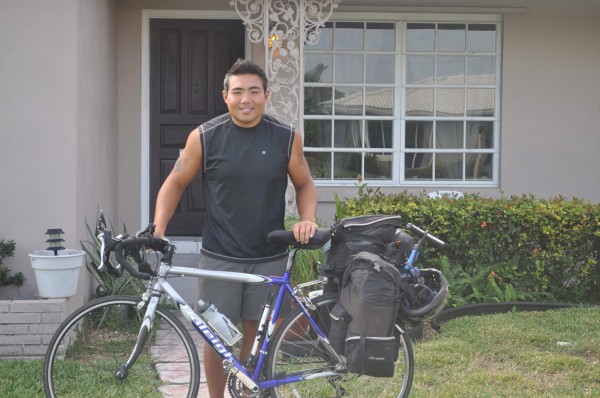Wesley Choy, restauranteur, certified public account, and former collegiate football player, was “flabberghasted” by a USA Today story. The story told of women in their 60s who rode from Georgia to Canada, bicycling along the path that their ancestors took on the Underground Railroad. It made Choy think about how he had avoided learning Chinese and Chinese culture. He also thought about his recently deceased father. When he went through his late father’s papers, he read copies of letters his father had sent to a friend in China. His father regretted that he learned too late the importance of experiencing what he valued the most – a “bucket list” if you will. Inspired by the underground railroad story and his father’s regrets, Choy sold his restaurant and embarked on a bicycle trip across the United States that would raise money for a number of causes and let him visit Chinese-American historical sites. He called his trip the “Tour du Culture” and created a web site that tracked his travels.
Fascinated by his story, I asked him a number of questions:
You played football at the intercollegiate level. Were you recruited or were you a walk-on?
I played at the NCAA Division III level and I was recruited.You mention that you were traveling in search of Chinese-American historical sites. What were some of the sites you visited?
I visited many of the Chinatowns along the East Coast and West Coast of the United States. They all were quite similar, but within each I found some unique historical markers and buildings (i.e. A building where the first Chinese owned businesses were thought to have been that sprung entire Chinatowns or buildings where Chinese had to seek refuge during the turbulent times around the Chinese Exclusion Act of 1882).Although I did ride thru Wyoming, I unfortunately did not get to visit Rock Springs, WY (which was on my list, but I’ll have to return via automobile one day) because this was the scene of the most violent (that was reported on anyway) incidents resulting from the Anti-Chinese sentiiment of the time: The Rock Springs Massacre of 1885. 28 Chinese were killed just for being Chinese.
A very unique place I visited was in Butte, Montana. After the copper boom there coinciding with the completion of the transcontinental railroad, many Chinese migrated to this small town and set up restaurants, doctors offices and various other businesses to support all the miners. A museum is actually located there preserving much of this history.
When I rode thru Ohio, I made it a point to go see these historical markers after reading this article about Chinese Soldiers in the American Civil war: www.hmdb.org/marker.asp?marker=26933. In San Luis Obispo, CA, I saw a monument dedicated to the Chinese who worked and gave their lives in helping Western Expansion. In this town there are still mass graves where Chinese Laborers are buried after being killed during the dangerous work of laying railroads along the mountains of the western coast.
I highly enjoyed seeing the Chinese American Soldiers Memorials in New York City and in Seattle because my grandfather fought for the United States in WWII.
Now that you are finished with your tour, what are your plans?
I plan on translating my adventures into a book. I also plan on continuing my culinary career.What are some lessons that you learned from your fathers letters and your trip that you would like people to know?
The main lesson that I learned that I would like to pass on is that Life is too short to not try and truly live it. Many people I know are comfortable going thru the motions or content with “just getting by” in life. I wouldn’t suggest the extreme that I did for everyone, but for me this trip was what I wanted to do. This was a way for me to live life out of my comfort zone; To experience life in a way that I could never fathom that I would ever do in one life-time.









